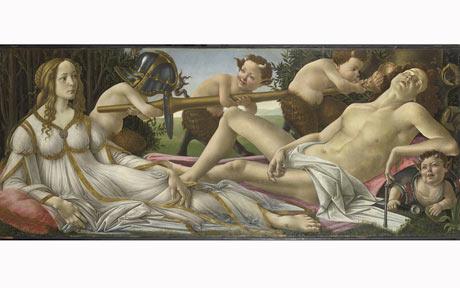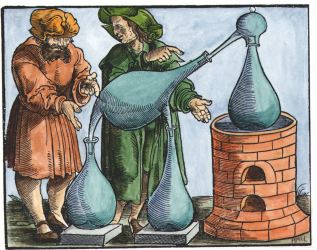| Author | Post |
|---|
Paul Ferguson
Member

| Joined: | Fri Feb 15th, 2008 |
| Location: | |
| Posts: | 1538 |
| Status: |
Offline
|
|
Posted: Thu May 27th, 2010 12:33 pm |
|
"A plant being held by a mischievous-looking satyr in the bottom right corner of the painting has been recognised as a specimen of Datura stramonium, a plant which causes madness and the urge to take one's clothes off."
http://www.telegraph.co.uk/culture/art/art-news/7770099/Botticellis-Venus-and-Mars-high-on-drugs.html
Interesting comments by readers, including one drawing attention to the mortar and pestle, and another one saying it's not datura at all but something else. See also Edmondo Solmi's alchemical comments.Attached Image (viewed 1170 times):
 Last edited on Fri May 28th, 2010 12:04 pm by Paul Ferguson
|
adammclean
Member

| Joined: | Fri Sep 14th, 2007 |
| Location: | United Kingdom |
| Posts: | 606 |
| Status: |
Offline
|
|
Posted: Mon May 31st, 2010 09:12 am |
|
A painting such as this from the late 15th century must be seen within the context of the paintings from which it arose. Throwing modern ideas at it and decontextualising its imagery from that which actually informed it, is a merely a modern mind game. Those who, sadly, seem at ease with taking drugs, often look at artwork and ideas from the past and suggest that it arose out of hallucinatory experiences. It is just wrong to present Bosch as a drug user, as it steals from him the origins of his art. Mystics influenced by alchemy, such as John Pordage, have had their mysticism put down to ergot intoxication, when it is obvious that it arises from a deep study and contemplation of Boehme.
This sort of interpretation of Botticelli's Venus and Mars being 'high on drugs', comes from the Dan Brown style of scholarship.
|
Paul Ferguson
Member

| Joined: | Fri Feb 15th, 2008 |
| Location: | |
| Posts: | 1538 |
| Status: |
Offline
|
|
Posted: Mon May 31st, 2010 09:26 am |
|
adammclean wrote:
A painting such as this from the late 15th century must be seen within the context of the paintings from which it arose. Throwing modern ideas at it and decontextualising its imagery from that which actually informed it, is a merely a modern mind game. Those who, sadly, seem at ease with taking drugs, often look at artwork and ideas from the past and suggest that it arose out of hallucinatory experiences. It is just wrong to present Bosch as a drug user, as it steals from him the origins of his art. Mystics influenced by alchemy, such as John Pordage, have had their mysticism put down to ergot intoxication, when it is obvious that it arises from a deep study and contemplation of Boehme.
This sort of interpretation of Botticelli's Venus and Mars being 'high on drugs', comes from the Dan Brown style of scholarship.
Agreed, but what are the plants (including a cactus?) in the bottom right-hand corner, why is Mars apparently resting his hand on a pestle and why is there a mortar under the chest of the satyr bottom-right?
Better view here with zoom facility:
http://www.nationalgallery.org.uk/paintings/sandro-botticelli-venus-and-mars
|
adammclean
Member

| Joined: | Fri Sep 14th, 2007 |
| Location: | United Kingdom |
| Posts: | 606 |
| Status: |
Offline
|
|
Posted: Mon May 31st, 2010 09:47 am |
|
Well, the application of biology to artworks is not a happy or successful one. Just consider the herbal section fo the Voynich manuscript and the many attempts by botanists to identify the plants shown there. It is more likely that artists like Botticelli, when adding in little details such as this, worked partly from life and partly from imagination. Think of Bosch's Garden of Earthly Delights - quite a few imagined plant forms there !
Are you sure the "mortar" is not a pewter wine vessel ? This makes more sense in the context of the painting. The "pestle" that Mars touches seems rather rod like, with symmetric ends. I thought pestles usually have a handle and a larger grinding end. So it may not be a pestle but some other rod like form.
The imagery of this painting, will, I expect, have been extensively analysed by previous generation of art historians in such journals as that of the Warburg and Courtauld Institutes. These I would be more happy to rely on, rather than the sloppy nonsense that is often passed off as art history today.
|
Paul Ferguson
Member

| Joined: | Fri Feb 15th, 2008 |
| Location: | |
| Posts: | 1538 |
| Status: |
Offline
|
|
Posted: Mon May 31st, 2010 10:26 am |
|
adammclean wrote:
Well, the application of biology to artworks is not a happy or successful one. Just consider the herbal section fo the Voynich manuscript and the many attempts by botanists to identify the plants shown there. It is more likely that artists like Botticelli, when adding in little details such as this, worked partly from life and partly from imagination. Think of Bosch's Garden of Earthly Delights - quite a few imagined plant forms there !
Are you sure the "mortar" is not a pewter wine vessel ? This makes more sense in the context of the painting. The "pestle" that Mars touches seems rather rod like, with symmetric ends. I thought pestles usually have a handle and a larger grinding end. So it may not be a pestle but some other rod like form.
The imagery of this painting, will, I expect, have been extensively analysed by previous generation of art historians in such journals as that of the Warburg and Courtauld Institutes. These I would be more happy to rely on, rather than the sloppy nonsense that is often passed off as art history today.
I must admit I didn't immediately identify them as a pestle and mortar myself.
Anyway this 'discovery' seems to have brought the 'hallucinogenic alchemy' gang out in force. See comment by Chewtoy here:
http://www.guardian.co.uk/artanddesign/jonathanjonesblog/2010/may/28/botticelli-venus-mars-drug
|
Alexander Guthrie Stewart
Member
| Joined: | Sat Feb 16th, 2008 |
| Location: | |
| Posts: | 192 |
| Status: |
Offline
|
|
Posted: Mon May 31st, 2010 12:30 pm |
|
Paul Ferguson wrote: adammclean wrote:
A painting such as this from the late 15th century must be seen within the context of the paintings from which it arose. Throwing modern ideas at it and decontextualising its imagery from that which actually informed it, is a merely a modern mind game. Those who, sadly, seem at ease with taking drugs, often look at artwork and ideas from the past and suggest that it arose out of hallucinatory experiences. It is just wrong to present Bosch as a drug user, as it steals from him the origins of his art. Mystics influenced by alchemy, such as John Pordage, have had their mysticism put down to ergot intoxication, when it is obvious that it arises from a deep study and contemplation of Boehme.
This sort of interpretation of Botticelli's Venus and Mars being 'high on drugs', comes from the Dan Brown style of scholarship.
Agreed, but what are the plants (including a cactus?) in the bottom right-hand corner, why is Mars apparently resting his hand on a pestle and why is there a mortar under the chest of the satyr bottom-right?
Better view here with zoom facility:
http://www.nationalgallery.org.uk/paintings/sandro-botticelli-venus-and-mars
I can assure you that all I can see in the bottom right hand side is a satyr inside Mar's breast and backplates, which are joined by buckled red leather, and holding his arming sword, which has a circular pommel of the sort common in swords throughout the medieval period, (I could even tell you what it is in the oakeshott classification if I had the book with me) and cross guard of a type that was also around at the time. The blade can be seen passing underneath the stuff that Mars is resting on, which isn't very safe, but being the god of war presumably means you have some invulnerability. That section of the sword is not perfectly drawn, so it looks as if the cross guard is not quite symmetrical and the blade, grip and pommel are not in a perfect line, but in no way can anything down there be thought of as a pestle and mortar.
|
adammclean
Member

| Joined: | Fri Sep 14th, 2007 |
| Location: | United Kingdom |
| Posts: | 606 |
| Status: |
Offline
|
|
Posted: Mon May 31st, 2010 12:39 pm |
|
I can assure you that all I can see in the bottom right hand side is a satyr inside Mar's breast and backplates, which are joined by buckled red leather, and holding his arming sword, which has a circular pommel of the sort common in swords throughout the medieval period.
Brilliant. You saw it clearly.
|
Paul Ferguson
Member

| Joined: | Fri Feb 15th, 2008 |
| Location: | |
| Posts: | 1538 |
| Status: |
Offline
|
|
Posted: Mon May 31st, 2010 01:12 pm |
|
adammclean wrote:
I can assure you that all I can see in the bottom right hand side is a satyr inside Mar's breast and backplates, which are joined by buckled red leather, and holding his arming sword, which has a circular pommel of the sort common in swords throughout the medieval period.
Brilliant. You saw it clearly.
OK, but rather poor draughtsmanship from Signor Botticelli I feel, as the quillians are not an equal length and are not precisely at 90 degrees to the handle. Probably one of his minions at work.Last edited on Mon May 31st, 2010 03:43 pm by Paul Ferguson
|
Alexander Guthrie Stewart
Member
| Joined: | Sat Feb 16th, 2008 |
| Location: | |
| Posts: | 192 |
| Status: |
Offline
|
|
Posted: Mon May 31st, 2010 03:41 pm |
|
Paul Ferguson wrote:
OK, but rather poor draftsmanship from Signor Botticelli I feel, as the quillians are not an equal length and are not precisely at 90 degrees to the handle. Probably one of his minions at work.
Oh, very definitely bad draughtsmanship. The link to the zoom facility was very useful, it helped get a closer view, because from further back I can see exactly how the crossguard looks like a pestle. But when I saw the blade and pommel it became clear it wasn't. I'm sure I've seen that sort of problem in other paintings from that period. Although in many smaller ones, with or without the use of perspective and mirrors and suchlike, many artists were drawing exact pictures, there were others who to my amateur eye were basically learning how to do depth on the fly.
|

Current time is 09:34 am | |
|
|
|

